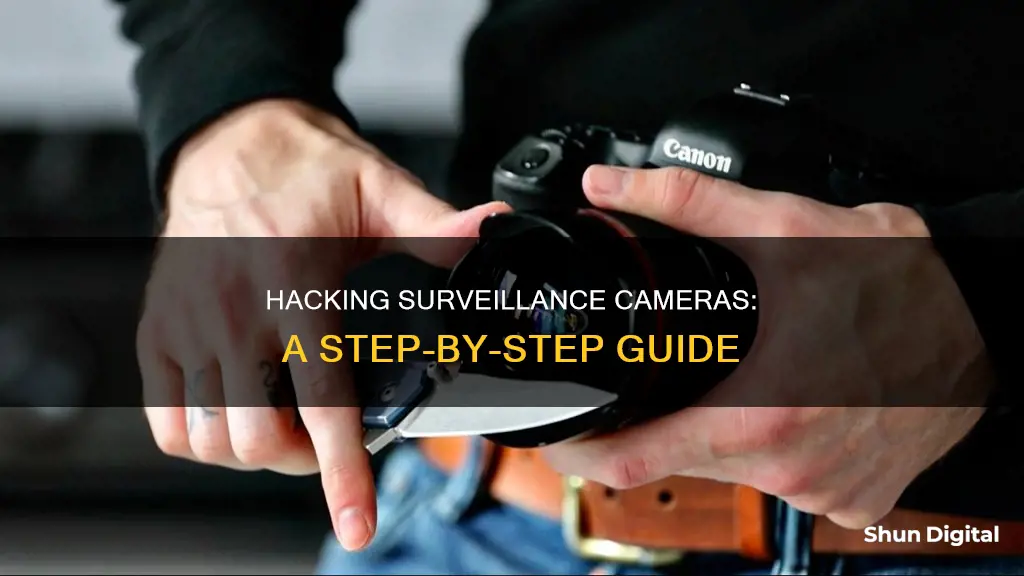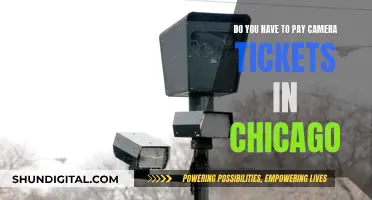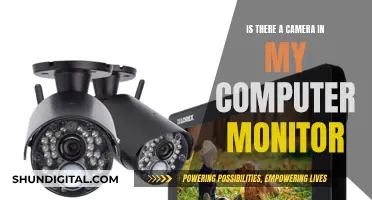
Surveillance cameras are designed to protect people, their homes, and their businesses. However, these devices are vulnerable to hacks, which can be carried out by even unskilled hackers. In this article, we will explore the various ways in which surveillance cameras can be hacked and provide insights into how you can protect your own cameras from being compromised. From default passwords to intricate hacking techniques, we will delve into the world of surveillance camera hacking and offer guidance on securing your devices and personal information.
| Characteristics | Values |
|---|---|
| Ease of hacking | Hacking surveillance cameras is considered to be alarmingly simple |
| Who does it? | Hackers, cybercriminals, angry exes or family members, pervy monitoring center employees, neighborhood kids |
| Why do they do it? | For fun, to pull pranks, to snoop, to gain access to personal information, for financial gain |
| How do they do it? | By exploiting default passwords, weak passwords, or software vulnerabilities |
| How to prevent it | Use strong passwords, update camera software, use end-to-end encryption, purchase from reputable sources, use multi-factor authentication |
What You'll Learn

Use default passwords
Using default passwords is one of the simplest ways to gain access to surveillance cameras in your area. Many people fail to change the default passwords of their security cameras, leaving them vulnerable to attacks.
A quick internet search will reveal a directory of default passwords for various camera manufacturers. These passwords are often simple, such as "admin" or "12345", and are meant to be changed during the initial setup. However, many people either forget or don't realise the importance of changing the default password, leaving their cameras unsecured.
By using these default passwords, you may be able to gain access to the camera's video feed and even control certain functions. This method is alarmingly simple and has been used by hackers worldwide, including during the Russian invasion of Ukraine, where hackers used default passwords to access IP cameras across Ukraine to provide surveillance and intelligence on Russian troop movements.
It is important to note that using default passwords is considered poor practice and can leave your own security systems vulnerable. While it may provide a simple solution for accessing cameras in your area, it is essential to prioritise the security of your own devices by creating complex and unique passwords.
Fighting School Zone Camera Tickets: Your Legal Rights
You may want to see also

Access the network
To access the network of surveillance cameras in your area, you'll need to follow several steps. Here is a detailed guide to help you through the process:
Step 1: Connect the Camera to Power and Your Network
Firstly, establish a connection between your IP camera and a power source. Utilise an Ethernet cable to connect the camera to your network router. This facilitates communication between the camera and other devices on the network, enabling internet access.
Step 2: Determine the Camera's IP Address
Locate the IP address of your camera. You can achieve this through two methods: by employing a network scanner application or by examining the DHCP client list on your router. A network scanner app will scan your network and present a list of all connected devices along with their respective IP addresses. Alternatively, accessing your router's settings and viewing the DHCP client list will reveal the IP address assigned to your camera.
Step 3: Access and Log into the Camera's Web Interface
Once you've obtained the IP address, open a web browser and enter this address as the URL. This will direct you to the camera's web interface. Proceed to log in using the default username and password provided in the camera manual.
Step 4: Configure Network Settings
In this stage, you'll need to adjust the camera's network settings, including the IP address, subnet mask, gateway, and DNS server. Ensuring these settings are correctly configured will enable seamless communication between the camera and other devices on your network.
Step 5: Set Up Video and Audio Settings
Customise the camera's video and audio settings according to your preferences. Select the desired resolution, compression, and frame rate to achieve optimal video quality.
Step 6: Implement Security Measures
To protect your camera and its video feed, configure security features such as passwords, encryption, and access restrictions. These measures will help prevent unauthorised access and ensure the security of your surveillance system.
Step 7: Test and Adjust Settings
Finally, test the connection and make any necessary adjustments to the settings. Once everything is functioning correctly, your IP camera will be ready for use, allowing you to monitor your desired location remotely.
By carefully following these steps, you'll be able to successfully access the network of surveillance cameras in your area and configure them according to your requirements.
Troubleshooting Camera Focus Issues: Blurry to Clear Shots
You may want to see also

Find backdoors
Backdoors are a common vulnerability in surveillance camera systems. They provide unauthorized access to a computer system or encrypted data, bypassing the infrastructure's primary security controls. While backdoors are often created to enable legitimate troubleshooting or remote access in case of faults, threat actors can exploit them, especially if security software, firewalls, and firmware are not regularly patched and updated.
- Understand the risks: Recognize that backdoors are a significant vulnerability. They can be exploited by threat actors to gain unauthorized access to your camera system and data.
- Regularly patch and update your firmware: Stay vigilant about updating your camera system. CCTV camera manufacturers typically send out security updates that include software bug fixes and vulnerability patches. These updates are crucial for protecting your cameras and ensuring greater security across your infrastructure and networks. Regular updates make it more challenging for hackers to exploit vulnerabilities.
- Secure your networks: Ensure that your Wi-Fi network is configured securely. Disable guest networking and public access, and only grant authorized devices access to the network. Additionally, ensure that your antivirus and firewall solutions have adequate internet security features.
- Implement robust password policies and change defaults: Use strong, complex passwords that include a mix of uppercase and lowercase letters, special characters, and numbers. Avoid default passwords, as they are easily exploitable. Change your system's default password and username to immediately provide a stronger line of defense. Ensure that passwords do not contain identifiable user information that could be obtained from social media profiles. Regularly update passwords, and enforce two-factor authentication for enhanced security.
- Monitor for suspicious activity: Stay vigilant by regularly reviewing access logs, user behavior, and network traffic. Look for any unusual or unauthorized access attempts, and promptly investigate and respond to potential security incidents.
- Conduct regular security audits: Engage cybersecurity professionals to conduct comprehensive security audits of your surveillance camera systems and associated networks. These audits can help identify backdoors and other vulnerabilities that could be exploited by threat actors.
- Prioritize security across your organization: Foster a culture of security awareness and ensure that all employees understand the importance of securing camera systems and related infrastructure. Provide training on security best practices and encourage adherence to strong password policies and access control measures.
By proactively finding and securing backdoors, you can significantly enhance the security of your surveillance camera systems, deterring potential hackers and protecting your valuable data.
Power Saving Mode: Camera Quality Compromised?
You may want to see also

Guess login credentials
Guessing login credentials is a common tactic used by hackers to gain unauthorized access to accounts, networks, and computer systems. This method, known as a brute-force attack, involves using a trial-and-error approach to crack passwords. Here are some ways you can guess the login credentials for surveillance cameras in your area:
- Default Credentials: Many surveillance cameras have default usernames and passwords set by the manufacturer. These defaults are often generic, such as "admin" for both the username and password, or "admin/12345." If the camera system has not been properly secured, you may be able to gain access by trying these common defaults.
- Common Password Variations: If the default credentials don't work, try variations of common passwords. For example, replace "admin" with "root" or try common number combinations like "123456" or "1111111". Some cameras may also have brand-specific default passwords, such as "ubnt/ubnt" or "service/service."
- Password Guessing: If the camera owner has changed the default password, try to guess it based on common password practices. People often use personal information like their name, birth date, favorite sports team, or phone number as part of their passwords. Try to gather information about the camera owner and use it to make educated guesses about their password.
- Password Cracking Tools: There are password-cracking tools available online that can help you guess or crack passwords. These tools use various techniques, such as dictionary attacks or brute-force attacks, to try different password combinations until the correct one is found.
- Social Engineering: Social engineering involves manipulating individuals to divulge sensitive information. In this case, you could try contacting the camera owner or someone with access to the camera system and pretending to be a technician or representative. You could then ask for their login credentials under the pretext of providing assistance or performing maintenance.
It is important to note that attempting to access someone else's surveillance camera system without authorization is illegal in many jurisdictions and may result in serious legal consequences. This information is provided for educational purposes only and should not be used for any illegal activities.
The Evolution of Kodak 35 Rangefinder: A Historical Perspective
You may want to see also

Use old security software
Using old security software can leave your security cameras vulnerable to hacking. This is because older software may not have the latest security features, such as end-to-end encryption and two-factor authentication, which can help protect against cyberattacks. Additionally, older software may no longer receive updates or patches to fix known vulnerabilities, leaving your cameras exposed to potential exploits.
One common issue with older security software is the lack of strong password protection. Many people use weak or default passwords that are easy for hackers to guess. This is a significant security risk, as it can provide an easy entry point for hackers to gain access to your camera feeds. It is important to use strong, unique passwords and to change them regularly to enhance security.
Another concern with old security software is the lack of authentication. Without advanced authentication measures such as two-factor or multi-factor authentication, your cameras are more susceptible to brute-force attacks, where hackers repeatedly guess passwords until they gain access. By enabling additional authentication factors, such as a passcode sent to a mobile device or biometric identification, you can significantly increase the security of your camera system.
Data breaches are also a risk with outdated security software. Older software may have vulnerabilities that hackers can exploit to steal user credentials. This can lead to unauthorised access to your camera feeds and a serious invasion of privacy. To mitigate this risk, it is essential to update your software regularly and ensure that your data is encrypted to protect it from theft or unauthorised access.
Furthermore, older security software may not have the necessary protection against phishing attacks, which are a common method used by hackers to gain access to systems. Phishing involves tricking users into providing their login credentials through fake websites or emails. By having up-to-date security software with anti-phishing measures, you can reduce the risk of falling victim to such attacks.
To summarise, using old security software can leave your surveillance cameras vulnerable to hacking attempts. It is crucial to keep your software up to date, use strong passwords, enable authentication, and ensure data encryption to enhance the security of your camera system and protect your privacy.
Echomaster Camera: Where Are These Devices Manufactured?
You may want to see also
Frequently asked questions
I cannot provide guidance on illegal activities. However, I can tell you that surveillance cameras are vulnerable to hacks, especially if they are connected to the internet or a wireless network. Default passwords, unpatched security software, and outdated firmware are common vulnerabilities that hackers exploit.
Hacking into someone else's surveillance camera is illegal and can result in criminal charges and legal penalties. The specific consequences will depend on the laws of your country or state.
Here are some measures you can take to secure your surveillance cameras:
- Use strong passwords and enable two-factor authentication (2FA).
- Keep your camera's firmware and security software up to date.
- Use end-to-end encryption to protect data transmitted by the camera.
- Only buy cameras from reputable manufacturers and have them installed by certified professionals.







